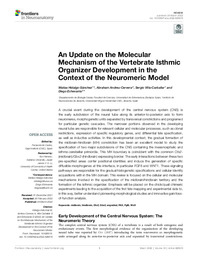Por favor, use este identificador para citar o enlazar este ítem:
https://hdl.handle.net/11000/34419
An Update on the Molecular Mechanism of the Vertebrate Isthmic Organizer Development in the Context of the Neuromeric Model
Título :
An Update on the Molecular Mechanism of the Vertebrate Isthmic Organizer Development in the Context of the Neuromeric Model |
Autor :
Hidalgo-Sánchez, Matías 
Andreu-Cervera, Abraham 
Villa Carballar, Sergio 
Echevarria, Diego  |
Editor :
Frontiers Media |
Departamento:
Departamentos de la UMH::Histología y Anatomía |
Fecha de publicación:
2022-03-24 |
URI :
https://hdl.handle.net/11000/34419 |
Resumen :
A crucial event during the development of the central nervous system (CNS) is the early subdivision of the neural tube along its anterior-to-posterior axis to form neuromeres, morphogenetic units separated by transversal constrictions and programed for particular genetic cascades. The narrower portions observed in the developing neural tube are responsible for relevant cellular and molecular processes, such as clonal restrictions, expression of specific regulatory genes, and differential fate specification, as well as inductive activities. In this developmental context, the gradual formation of the midbrain-hindbrain (MH) constriction has been an excellent model to study the specification of two major subdivisions of the CNS containing the mesencephalic and isthmo-cerebellar primordia. This MH boundary is coincident with the common Otx2- (midbrain)/Gbx2-(hindbrain) expressing border. The early interactions between these two pre-specified areas confer positional identities and induce the generation of specific diffusible morphogenes at this interface, in particular FGF8 and WNT1. These signaling pathways are responsible for the gradual histogenetic specifications and cellular identity acquisitions with in the MH domain. This review is focused on the cellular and molecular mechanisms involved in the specification of the midbrain/hindbrain territory and the formation of the isthmic organizer. Emphasis will be placed on the chick/quail chimeric experiments leading to the acquisition of the first fate mapping and experimental data to, in this way, better understand pioneering morphological studies and innovative gain/lossof-function analysis.
|
Palabras clave/Materias:
midbrain
hindbrain
Otx2
Gbx2
engrailed
PAX
Fgf8
Wnt1 |
Tipo de documento :
info:eu-repo/semantics/article |
Derechos de acceso:
info:eu-repo/semantics/openAccess
Attribution-NonCommercial-NoDerivatives 4.0 Internacional |
DOI :
10.3389/fnana.2022.826976 |
Publicado en:
Frontiers in Neuroanatomy. 2022 Mar 24:16:826976 |
Aparece en las colecciones:
Artículos Histología y Anatomía
|
 La licencia se describe como: Atribución-NonComercial-NoDerivada 4.0 Internacional.
La licencia se describe como: Atribución-NonComercial-NoDerivada 4.0 Internacional.

 La licencia se describe como: Atribución-NonComercial-NoDerivada 4.0 Internacional.
La licencia se describe como: Atribución-NonComercial-NoDerivada 4.0 Internacional.
.png)